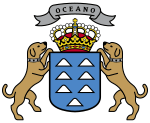Gran Canaria
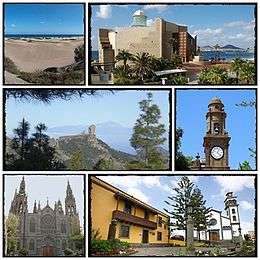 Top left: Maspalomas Dunes, Top right: Alfredo Kraus Audiorium, Middle left: Parque rural del Nublo (Nublo Rural Park), Middle right: Matriz Santiago de Los Caballero Church, Bottom left: Arucas Church, Bottom right: Casa Museo del Tomas Morales (The House Museum of Thomas Morales) | |
 | |
| Geography | |
|---|---|
| Location | Atlantic Ocean |
| Coordinates | 27°58′N 15°36′W / 27.967°N 15.600°W |
| Area | 1,560 km2 (600 sq mi) |
| Highest elevation | 1,949 m (6,394 ft) |
| Highest point | Pico de Las Nieves |
| Spain | |
| Region | Macaronesia |
| Autonomous Community | Canary Islands |
| Province | Las Palmas |
| Largest settlement | Las Palmas (pop. 383,308) |
| Demographics | |
| Population | 847,830[1] (2015) |
| Pop. density | 543 /km2 (1,406 /sq mi) |

Gran Canaria (Spanish pronunciation: [ɡɾaŋ kaˈna.ɾja]; originally meaning "Great [Island] of Dogs") is the second most populous island of the Canary Islands, an African archipelago which is part of Spain, with a population of 847,830 (in 2015) that constitutes approximately 40% of the population of the archipelago. Located in the Atlantic Ocean about 150 kilometres (93 mi) off the northwestern coast of Africa and about 1,350 km (840 mi) from Europe.[2] With an area of 1,560 km2 (602 sq. mi)[3] and an altitude of 1,956 m (6,417 ft)[4] at the Pico de las Nieves, Gran Canaria is the third largest island of the archipelago in both area and altitude.
Gran Canaria was populated by the Canarii, who may have arrived as early as 500 BC. The Canarii called the island Tamarán or Land of the Brave. After over a century of European incursions and attempts at conquest, the island was conquered on April 29, 1483, after a campaign that lasted five years, by the Crown of Castile, with the support of Queen Isabella I, a conquest which turned out to be an important step towards the expansion of the unified Spain.
The capital city of Las Palmas de Gran Canaria was founded on June 24, 1478, under the name "Real de Las Palmas", by Juan Rejón, head of the invading Castilian army. In 1492, Christopher Columbus anchored in the Port of Las Palmas (and spent some time on the island) on his first trip to the Americas. Las Palmas de Gran Canaria is, jointly with Santa Cruz de Tenerife, the capital of the autonomous community of the Canary Islands.
Geography
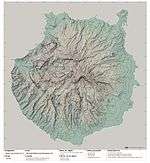
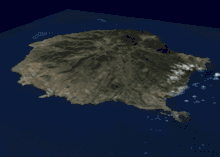
Gran Canaria is located southeast of Tenerife and west of Fuerteventura. The island is of volcanic origin, mostly made of fissure vents. Gran Canaria's surface area is 1,560 km² and its maximum elevation is 1,949 meters (Pico de Las Nieves). It has a round shape, with a diameter of approximately 50 km.
Geology
About 80% of the volume of the island was formed during the Miocene period, between 14 and 9 million years ago. This is called the "Old Cycle" and is estimated to have lasted some 200,000 years and have emitted about 1000 km3, mostly of fissural alkali basalt. This cycle continued with the emission of trachytes, phonolites and peralkaline rocks. This period was followed by one of erosion, which lasted some 4 million years.[5]
A second cycle of volcanic eruptions, known as the "Roque Nublo cycle", took place between 4.5 and 3.4 million years ago. This shorter cycle emitted about 100 km3. Most of the inland peaks were formed by erosion from these materials. This period also started with fissural basalts, but ended with violent eruptions of pyroclastic flows. Some phonolitic features, like the Risco Blanco, were also formed in its last stages.[5]
The third or recent cycle is held to have started some 2.8 million years ago and is considered to be still active. The last eruptions are held to have occurred some 3500 years ago.[5]
The changes in volume and, therefore, weight of the island have also caused the island to rise above the previous sea level during erosive periods and to sink during eruptive periods. Some of these "fossil beaches" can be seen in the cliff faces of the more eroded northern coast.[6]
Vegetation
Until the conquest, Gran Canaria had extensive forests, but then suffered extensive deforestation[7] as a result of continuous logging, land divisions and other intensive uses. This caused the forest cover to be reduced to just 56,000 hectares,[7] making the island the most deforested of the Canary Islands.[8] However, in the twentieth century reforestation of the ridge of the island was begun, recovering some of the lost forest mass. Much of the summit of the island is forested mostly due to reforestation.[7]
Municipalities

Gran Canaria is divided into twenty-one municipalities:
The island has a population of 845,676 with 378,628 (year 2005) of those in the capital city of Las Palmas de Gran Canaria. Gran Canaria is the second most populous island of the Canary Islands, after Tenerife.[9] Las Palmas de Gran Canaria is the capital of the province of Las Palmas, and also one of the two capitals of the autonomous community of the Canary Islands, along with Santa Cruz de Tenerife.
Transportation
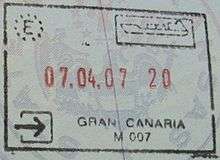
Gran Canaria has roads encircling the whole island and extending into the mountain areas. In the late 20th century, its motorways, among the first in the Canary Islands, were opened and run around Las Palmas de Gran Canaria, and were later extended to the north coast and the airport and subsequently to the south coast in response to increased tourist traffic. The high-speed motorways are GC1, GC2, and GC31, and dual carriageways GC4 and GC5. The western and the north-western parts, with the fewest inhabitants, are linked only with main roads.
Gran Canaria Airport (IATA: LPA) is the only commercial airport on the island. The large number of aircraft and passengers passing through it each year make it one of the busiest in Spain. Gran Canaria is also responsible for all air traffic control in the Canaries.
The most important ports in the island are the Port of Las Palmas (Puerto de la Luz), in the city of Las Palmas de Gran Canaria; Arguineguín, which exports cement from a large factory; and Arinaga, located in the main industrial zone of Canaries and one of the major ones of Spain. The ports which transport the most passengers are the Port of La Luz and the Port of Las Nieves, located in the municipality of Agaete.
Plans for a railway network linking the capital with the south have been approved by both the Gran Canaria Cabildo and the autonomic Canary Islands' Government, though the discussion with the central Spanish Government hinges now on budget.
Climate
Gran Canaria is noted for its rich variety of microclimates. Generally speaking though, the average daytime high ranges from 20 °C (68 °F) in winter, to 26 °C (79 °F) in summer. Some cool nights occur in winter, but lows below 10 °C (50 °F) are unknown near the coast. Inland the climate is still mild but mountainous areas see the occasional frost or snow. Annual rainfall averages 228 mm (9.0 in), most of this falling in the cooler months, with July, August and September normally rainless. Rainfall is unevenly distributed through the island with some areas being much drier than others. Cloud cover and sunshine is often quite variable during the cooler months, and there can be several rather cloudy days at times in winter. Summers are generally quite sunny however, with the south of the island being most favoured.
| Climate data for Gran Canaria Airport (1981-2010) | |||||||||||||
|---|---|---|---|---|---|---|---|---|---|---|---|---|---|
| Month | Jan | Feb | Mar | Apr | May | Jun | Jul | Aug | Sep | Oct | Nov | Dec | Year |
| Average high °C (°F) | 20.8 (69.4) |
21.2 (70.2) |
22.3 (72.1) |
22.6 (72.7) |
23.6 (74.5) |
25.3 (77.5) |
26.9 (80.4) |
27.5 (81.5) |
27.2 (81) |
26.2 (79.2) |
24.2 (75.6) |
22.2 (72) |
24.2 (75.6) |
| Daily mean °C (°F) | 17.9 (64.2) |
18.2 (64.8) |
19.0 (66.2) |
19.4 (66.9) |
20.4 (68.7) |
22.2 (72) |
23.8 (74.8) |
24.6 (76.3) |
24.3 (75.7) |
23.1 (73.6) |
21.2 (70.2) |
19.2 (66.6) |
21.2 (70.2) |
| Average low °C (°F) | 15.0 (59) |
15.0 (59) |
15.7 (60.3) |
16.2 (61.2) |
17.3 (63.1) |
19.2 (66.6) |
20.8 (69.4) |
21.6 (70.9) |
21.4 (70.5) |
20.1 (68.2) |
18.1 (64.6) |
16.2 (61.2) |
18.2 (64.8) |
| Average precipitation mm (inches) | 25 (0.98) |
24 (0.94) |
13 (0.51) |
6 (0.24) |
1 (0.04) |
0 (0) |
0 (0) |
0 (0) |
9 (0.35) |
16 (0.63) |
22 (0.87) |
31 (1.22) |
151 (5.94) |
| Average precipitation days (≥ 1 mm) | 3 | 3 | 2 | 1 | 0 | 0 | 0 | 0 | 1 | 2 | 4 | 5 | 21 |
| Mean monthly sunshine hours | 184 | 191 | 229 | 228 | 272 | 284 | 308 | 300 | 241 | 220 | 185 | 179 | 2,821 |
| Source: Agencia Estatal de Meteorología ,[10] Agencia Estatal de Meteorología[11] | |||||||||||||
Agriculture
Gran Canaria agriculture is unique among the Canaries islands in that it was traditionally dominated by plantations, with much of these being grains as well as sugarcane, rather than by stock-breeding.[12] The caves of Valerón (a property of cultural interest in the "archaeological site" category) in the municipality of Santa María de Guía bears testimony of it by being the largest pre-Hispanic collective granary of the Canaries.
Tourism
.jpg)
.jpg)
This island is called a "Miniature Continent" due to the different climates and variety of landscapes found, with long beaches and dunes of white sand, contrasting with green ravines and picturesque villages.[13] A third of the island is under protection as a Biosphere Reserve by UNESCO.
The number of annual visitors was 3.6 million in 2014 (of which 450.000 Spaniards).[14] Most of the tourists visit the southern part of the island. The north tends to be cooler, while the south is warmer and sunny. The east coast of the island is flat, dotted with beaches, while the western coast is rockier and mountainous.
The island possesses 32 Natural Protected Spaces,[15] notably the Rural Park of Nublo, The Doramas Jungle, the Azuaje Ravine, Tamadaba, Pino Santo, etc.
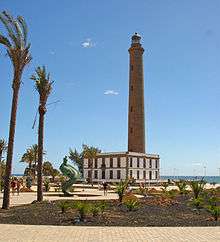
In the south there is a large bird park, Palmitos Park, as well as many beach resort communities. Resorts are concentrated in the central eastern part of the southern coast in the Maspalomas area, which includes the towns of San Agustín, Playa del Inglés and Meloneras. The Maspalomas Dunes are located between Playa del Inglés ("The Englishman's Beach") and the distinctive 19th century Maspalomas lighthouse.
In Tarajalillo, an Aeroclub exists from where tourist flights can be taken over the island.
Still further to the west along the southern shore, in the Municipality of Mogán, are the communities of Puerto Rico and Puerto de Mogán, a village referred to as "Little Venice" on account of its many canals.
Other attractions include Cocodrilos Park, Roque Nublo (an 80 m monolith), Cenobio de Valerón with more than 350 storage cavities, Painted cave of Galdar the most important archaeological park in Canary Islands, or the botanical gardens Jardín Canario (in Tafira Alta) and Cactualdea (in La Aldea de San Nicolás).
El Dedo de Dios, or "God's Finger", was a rocky spire jutting from the sea in Puerto de las Nieves, and was previously the signature attraction of the Canary Islands until it was destroyed by tropical storm Delta that crossed the archipelago on November 2005.[16]
Other well-known rock formations are El Cura (also known as El Fraile), The Frog (La Rana), Roque Bentayga, the Roque de Gando, and the Peñón Bermejo. The highest peak of the island is the Pico de las Nieves, at 1,950 metres (6,400 ft).
The capital city is Las Palmas de Gran Canaria. Las Canteras beach, a protected area and diving zone, lies in the heart of the city. Las Palmas de Gran Canaria is also known for its annual carnaval. It was the first stop of Christopher Columbus' expedition on his way back from the Americas,[17] a commemoration of which is the Hermitage of San Antonio Abad, where the navigator prayed, and the Casa de Colón. Other attractions in the capital city include the Museo Canario (the most important archaeology museum in the archipelago), the cathedral and the Plaza del Espíritu Santo. In Teror the shrine of Virgen del Pino ("Virgin of the Pine"), patron saint of Gran Canaria, can be found. Its feast is celebrated on September 8.
The town of Agüimes, on the eastern part of the island, has been carefully restored and its town centre, centered on its old church and a peaceful square, now evokes the quiet living of a traditional Canarian town. The district also has some of the best preserved cave dwellings, in the protected area of the Guayadeque ravine, where even the church has been built into the mountainside and visitors can find a number of popular cave restaurants. The district also includes the most renowned scuba diving area on the island: the marine reserve at the playa de El Cabrón just outside the town of Arinaga.
Other important towns are Telde, known among other things for their surf schools in Salinetas, Vecindario (within the municipality of Santa Lucía de Tirajana) and Gáldar, that contains an important diving zone. In Arucas there is a Neogothic temple, popularly known as "Arucas' Cathedral", as well as a large fertile plain where bananas are grown. In Gáldar and its surroundings there is also a banana-growing plain and some remarkable archaeological remains,[18] such as the Painted cave of Galdar or the cenobio de Valerón's communal silos, ancient tombs (among which the necropolis of Maipés), and the port of Sardina del Norte (one of the island's ports where, as in Las Palmas', Christopher Columbus used to get supplies for his ships).
Heading west along the southern coast is the fishing city of Arguineguín in the Municipality of Mogán.
Natural symbols
The official symbols from nature associated with Gran Canaria are Canis lupus familiaris (Canary Mastiff) and Euphorbia canariensis (Cardón)[19]
Protected natural areas

Nearly half of the island territory — 667 km² (42.7% of island) — is under protection from the Red Canaria de Espacios Naturales Protegidos (Canary Islands Network for Protected Natural Areas). Of the 146 protected sites under control of network in the Canary Islands archipelago,[20] a total of 33 are located in Gran Canaria, the second most protected island in the group. [21] There are seven different categories of protection:
- Six nature reserves — El Brezal, Azuaje, Los Tilos de Moya, Los Marteles, Las Dunas de Maspalomas and Güigüi (total 7,153.1 ha)
- Two integral nature reserves — Inagua and Barranco Oscuro (total 3,955,5 ha)
- Two natural parks — Tamadaba and Pilancones (total 13,333 ha)
- Two rural parks — Nublo and Doramas (total 29,893.4 ha)
- Ten natural monuments — Amagro, Bandama, Montañón Negro, Roque de Aguayro, Tauro, Arinaga, Barranco de Guayadeque, Riscos de Tirajana, Roque Nublo and Barranco del Draguillo (total 5,264.9 ha)
- Seven protected landscapes — La Isleta (in the capital Las Palmas de Gran Canaria), Pino Santo, Tafira, Las Cumbres, Lomo Magullo, Fataga and Montaña de Agüimes (total 12,680.9 ha)
- Four sites of scientific interest — Jinámar, Tufia, Roque de Gando and Juncalillo del Sur (total 276.2 ha).[15]
Sports
.jpg)
The island is home to CB Gran Canaria - a basketball club playing in Liga ACB at the Gran Canaria Arena, with a capacity of 11,000. The island is also home to UD Las Palmas - a football club playing in Liga BBVA at the Estadio de Gran Canaria, with a capacity of 32,392.
See also
Bibliography
- Andrews, Sarah; Quintero, Josephine (2007). Canary Islands. Lonely Planet. ISBN 1741045959.
References
- ↑ Cifras de población resultantes de la revisión del Padrón municipal referidas al 1-1-15, Boletín Oficial del Estado
- ↑ Situación y Clima. Ayuntamiento de Las Palmas de Gran Canaria. Archived 2010-06-29 at the Wayback Machine.
- ↑ ISTAC: Estadísticas de la Comunidad Autónoma de Canarias (Statistics for the Canaries) on gobiernodecanarias.org.
- ↑ Geography and toponymy data on ign.es].
- 1 2 3 Araña, V and Carracedo, J.C: Canarian Volcanoes, Volume 3: Gran Canaria, pp. 8, 24. Editorial Rueda, Madrid, 1978.
- ↑ Oscillations of up to 400 metres in the level corresponding to sea level have occurred in geological history. The highest point known is in the Bay of El Confital, Las Palmas (130m above current sea level) while subaerial materials have been extracted from a well at 230m below sea level in the area of La Aldea. Araña, V and Carracedo, J.C: Canarian Volcanoes, Volume 3: Gran Canaria, pp. 13. Editorial Rueda, Madrid, 1978.
- 1 2 3 Reforestación de las cumbres de Gran Canaria
- ↑ “Con lo que cuesta un Jumbo se puede reforestar toda Gran Canaria”
- ↑ Population data corresponding to January 2010, according to the Instituto Nacional de Estadística
- ↑ "Standard Climate Values. Gran Canaria Aeropuerto".
- ↑ "Guía resumida del clima en España (1981-2010)". Archived from the original on 2012-11-18.
- ↑ Cenobio de Valeron, section "El yacimiento arqueologico". On arqueologiacanaria.com.
- ↑ Gran Canaria – Official Canary Islands Tourism
- ↑ "Situation Of The Tourism Sector, Year Ending 2014" (PDF). The Official Gran Canaria Tourist Website. Cabildo de Gran Canaria. Retrieved 12 March 2016.
- 1 2 Espacios Naturales Protegidos de Gran Canaria Font: Gobierno de Canarias
- ↑ BBC NEWS - Tropical Storm Delta batters Canaries.
- ↑ Andrews & Quintero 2007, p. 29.
- ↑ Interactive map of Heritage sites on Grand Canary island. On estodotuyo.com, site on Heritage assets by the council of Grand Canary.
- ↑ Ley 7/1991, de 30 de abril, de símbolos de la naturaleza para las Islas Canarias
- ↑ Red Canaria de Espacios Naturales Protegidos
- ↑ Relación de los Espacios Naturales protegidos de Gran Canaria
External links
| Wikimedia Commons has media related to Gran Canaria. |
- Gran Canaria Tourist Board official site
 Gran Canaria travel guide from Wikivoyage
Gran Canaria travel guide from Wikivoyage- Gran Canaria Local blog
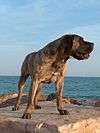
_11.jpg)
